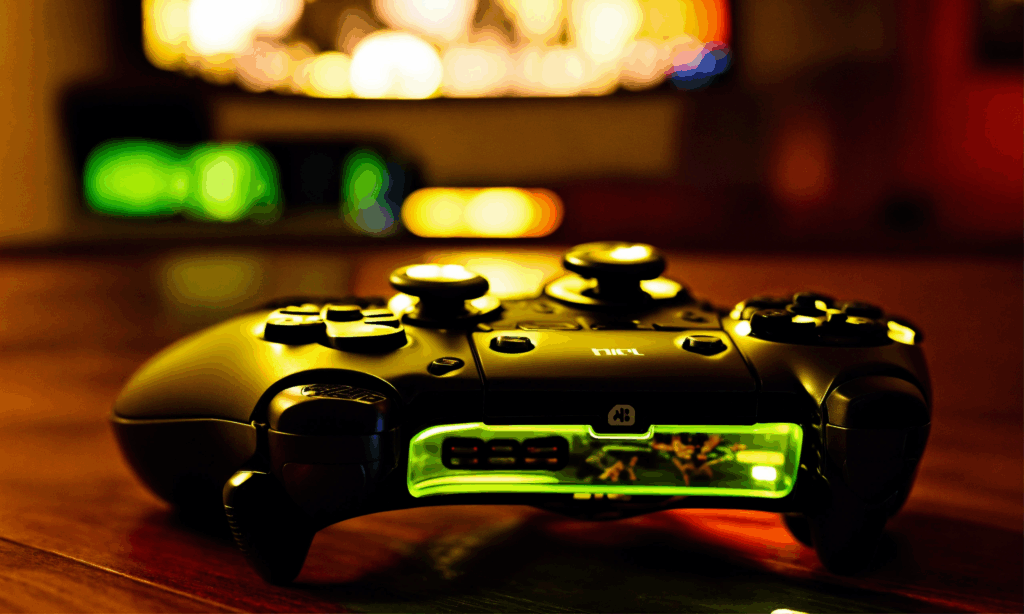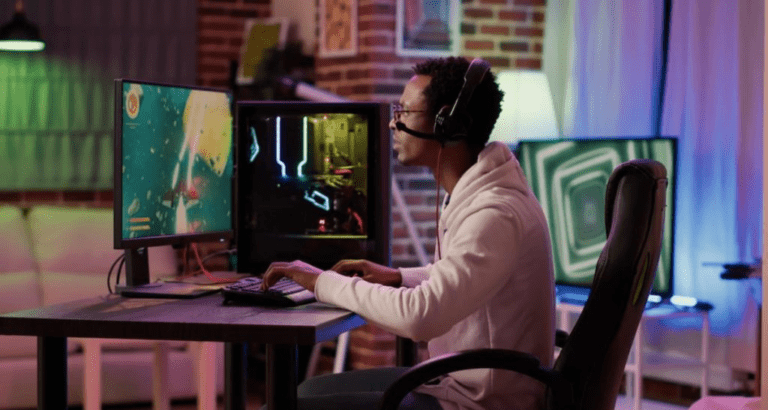Imagine a controller that doesn’t just respond to your commands but anticipates them. A device that learns your reflexes, compensates for your fatigue, and transforms clumsy inputs into flawless executions. This isn’t science fiction; it’s the reality of today’s AI game controller, a seismic shift in the world of video games.
Unlike traditional controllers with static responses, these intelligent peripherals use machine learning algorithms and sensor networks to create deeply personalized gameplay experiences. For developers and gamers alike, understanding this technology isn’t just about keeping up with trends: it’s about pioneering the future of interactive entertainment.
So let’s delve deep into this topic and uncover the current and future state of AI game controller, and how it can completely change the way we interact with the video game media.
You may also like: Game monetization models – 5 ways in which games can profit
AI game controller: from D-pads to neural networks
The journey from single-button joysticks to adaptive AI interfaces mirrors gaming’s transformation into a complex sensory art form.

Early controllers were simple input translators, but modern AI game controllers like the AI Shark Controller embed layers of intelligence beneath their surfaces. These devices incorporate pressure-sensitive grips capable of detecting subtle muscle tension and finger positioning shifts, providing unprecedented insight into player state.
Inertial measurement units track micro-movements and tilt dynamics far beyond basic motion controls, while dedicated machine learning processors analyze thousands of input patterns per second in real-time.
This sophisticated sensor array creates a continuous biofeedback loop, allowing the controller to make micro-adjustments to stick sensitivity, trigger resistance, or button actuation points before the player consciously registers the need.
During a high-stakes Call of Duty firefight, for instance, the controller might detect increased grip pressure and erratic thumbstick movements indicative of stress. It could then autonomously reduce sensitivity just enough to stabilize aiming reticles without compromising responsiveness, effectively acting as a shock absorber for nervous system feedback.
This evolution turns plastic and circuitry into a dynamic interface that morphs with the player’s physiological state.
The intelligence beneath the plastic
At the core of an AI game controller lies its predictive input algorithms, which transform raw data into personalized assistance. Unlike basic button remapping, these systems observe gameplay patterns across multiple sessions, building an evolving player profile that identifies unique strengths and compensatory needs.
The AI Shark Controller exemplifies this by meticulously studying combo execution timing in fighting games, pinpointing exactly where complex input sequences break down most frequently. It analyzes movement efficiency in platformers, noting habitual over-correction during precision jumps or subconscious input hesitation at critical moments.

Crucially, it also monitors fatigue patterns, recognizing when reaction times measurably slow during extended gaming sessions through subtle input latency metrics. This rich dataset trains neural networks embedded directly in the controller’s firmware, enabling context-aware adjustments invisible to the user.
For example, if a player consistently misses 30% of rightward dodges in Elden Ring, the AI might extend that specific input window by milliseconds while maintaining standard timing for other maneuvers.
This isn’t cheating, it’s contextual adaptation, functioning like a digital caddy in golf who subtly adjusts club recommendations based on a player’s recurring slice. The controller becomes an extension of the player’s intent, smoothing the gap between thought and action.
Read also: Direct-to-consumer games – a new era of game development?
Bridging skill gaps: from new players to e-sports veterans
The true revolution of AI game controllers lies in their unprecedented democratization of gaming mastery, catering to opposite ends of the skill spectrum with equal finesse. For novices overwhelmed by complex control schemes, these devices act as patient, invisible tutors.
When detecting consistent input struggles during a complex Street Fighter combo sequence, the controller can temporarily simplify commands without altering on-screen animations, reducing frustration while maintaining visual feedback integrity.
Graduated haptic pulses guide thumb positioning across the D-pad or face buttons, offering tactile coaching that accelerates muscle memory development. Through companion apps, it might even suggest contextual remapping tailored to an individual’s recurring mistakes, turning barriers into learning opportunities.
Conversely, veteran players benefit from precision fine-tuning beyond human capability. Professional Apex Legends competitors leverage AI to maintain frame-perfect slide jumps and recoil control during marathon tournament sessions where microscopic muscle fatigue accumulates.
The controller learns their peak performance patterns and applies real-time micro-compensations as reaction times dip imperceptibly, functioning like an AI-powered pit crew constantly fine-tuning a Formula 1 car mid-race.

This dual capability transforms the controller from a passive tool into an active skill amplifier, adapting its role based on the player’s evolving needs throughout their gaming journey.
Does it go beyond entertainment?
The implications of adaptive controllers extend far beyond recreational gaming into transformative therapeutic applications.
Research platforms like BrightBrainer Grasp demonstrate how AI game controller technology revolutionizes assistive devices and rehabilitation tools. Their stroke recovery controller employs highly sensitive force sensors that quantitatively measure incremental grip strength improvements across therapy sessions, providing clinicians with objective progress data.
Advanced movement prediction algorithms compensate for motor control limitations, interpreting shaky inputs as intended smooth motions within game worlds. Crucially, real-time difficulty scaling keeps therapeutic games engaging yet achievable, automatically adjusting challenges based on minute-to-minute performance fluctuations.
Patients recovering hand mobility after neurological events achieve significantly higher therapy compliance and engagement using such systems, as the controller invisibly tailors virtual environments to their capabilities.
This represents a paradigm shift: where accessibility was once addressed through specialized add-ons, AI integration makes the core controller itself the adaptive solution. It opens gaming, and its cognitive and motor benefits, to demographics previously excluded by standard input devices’ physical demands, turning play into powerful medicine.

Tomorrow’s interface: where AI controllers are heading
The next evolutionary leap for AI game controllers promises even deeper integration between player physiology and virtual worlds, blurring the lines between interface and extension of self.
Emerging prototypes like Meetion’s experimental models incorporate sophisticated biometric feedback systems, using palm sensors to monitor heart rate variability and galvanic skin response. This enables dynamic difficulty adjustment during stress spikes, potentially reducing enemy aggression when players approach cognitive overload.
Cross-device learning ecosystems will synchronize AI profiles across controllers, gaming mice, and VR headsets, creating a unified understanding of playstyle that transitions seamlessly between platforms.
Environmental awareness represents another frontier; built-in cameras and LiDAR sensors map physical living spaces, enabling controllers to project context-aware holographic interfaces via emerging spatial computing technologies, turning any surface into a tactile control panel.
But perhaps the most transformative is the move toward proactive coaching, controllers analyzing playstyle gaps compared to elite player datasets and generating personalized improvement drills within game environments.
These advancements collectively suggest a future where “controller” becomes an outdated term; these devices evolve into true gaming partners that perceive, adapt, and collaborate in achieving player objectives, fundamentally redefining human-machine interaction in play.
Here at Main Leaf, we view AI game controllers not as replacements for creative game design, but as collaborators expanding the canvas of interactive possibilities. Our development philosophy has evolved to harness this synergy, incorporating AI input simulation during rigorous playtesting phases.
This allows us to predict how adaptive hardware influences game balance and difficulty curves long before public release, ensuring experiences remain engaging whether played on traditional or AI-enhanced devices.
For studios like us embarking on next-generation projects, this technology represents a paradigm shift as significant as the advent of touchscreens or motion controls. The window for experimentation is now, whether building therapeutic experiences or competitive esports titles.
Ready to pioneer gaming’s intelligent interface frontier? Partner with us here at Main Leaf to build experiences that don’t just respond to players but profoundly understand them!

